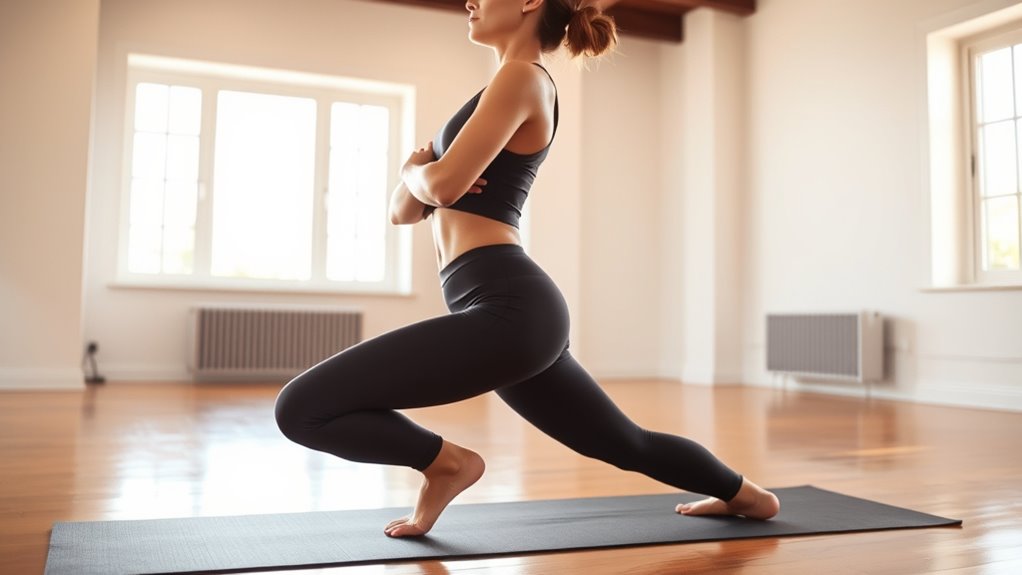To create pelvic-floor friendly home workouts, focus on gentle exercises like pelvic floor activation, core stability routines, and slow stretches to improve flexibility. Incorporate low-impact cardio, such as marching in place or side steps, with proper posture and mindful breathing to support pelvic strength. Balance and coordination drills can boost stability, while maintaining smooth, controlled movements. Keep up with these safe practices to enhance your pelvic health—you’ll discover how each element works together for better wellness.
Key Takeaways
- Incorporate gentle pelvic floor activation exercises like controlled contractions and releases in a comfortable, relaxed position.
- Focus on core stability routines such as pelvic tilts and bird dogs with mindful breathing.
- Practice posture and movement awareness to maintain proper alignment and prevent strain during workouts.
- Include low-impact cardio activities like marching in place or side steps to support circulation without overloading the pelvic floor.
- Ensure all stretches and movements are gentle, controlled, and avoid pain, emphasizing gradual flexibility and balance improvements.
Gentle Pelvic Floor Activation Exercises

Starting with gentle pelvic floor activation exercises is a great way to introduce your muscles to regular practice without overwhelming them. These exercises help you become aware of your pelvic muscles and build a foundation for stronger support. To begin, find a comfortable position, like lying on your back with knees bent. Inhale deeply, then gently contract your pelvic muscles as if stopping the flow of urine. Hold the contraction for a few seconds, then slowly release. Focus on smooth, controlled movements without tensing other muscles like your thighs or buttocks. Repeat this process 10 times, gradually increasing your hold time as you gain strength. Consistency is key—you’ll notice improvements in muscle tone, control, and overall pelvic health over time. Incorporating these exercises can also boost your overall pelvic-floor health.
Core Stability Routines for Pelvic Health

A strong core provides essential support for your pelvic health, helping to stabilize your pelvis and improve posture. Incorporate exercises like gentle planks, bird dogs, and pelvic tilts into your routine. These move your deep abdominal and back muscles, enhancing overall stability. Focus on controlled, deliberate movements to activate your core muscles without straining your pelvic floor. Remember to breathe steadily and avoid holding your breath. Consistency is key—aim for daily or every-other-day sessions. As your core strengthens, you’ll notice better balance and reduced pelvic discomfort. Always listen to your body, and if an exercise causes pain, stop and adjust. Building core stability not only benefits your pelvic health but also supports your daily movements and overall well-being.
Low-Impact Cardio Movements at Home

Building on your core stability routines, incorporating low-impact cardio exercises at home can boost your pelvic health without putting excessive strain on your muscles. These movements increase your heart rate gently, improving circulation and overall endurance. Activities like marching in place, step touches, or side steps are easy to do and easy on your pelvic floor. You can also try low-impact dancing or gentle side-to-side lunges, making workouts enjoyable and sustainable. Focus on controlled movements and steady breathing to avoid unnecessary strain. Consistency is key—aim for 15-20 minutes a few times weekly. These exercises help maintain pelvic strength, support circulation, and boost your energy levels—all without risking pelvic floor stress. Remember, gentle is better; listen to your body. Incorporating safe exercise practices ensures you protect your pelvic health while staying active.
Posture and Alignment Drills

Focusing on proper posture and alignment helps you activate your pelvic floor muscles effectively. Learning core engagement techniques guarantees your entire body stays stable during exercises. When you maintain good form, you’ll see better results and reduce the risk of injury.
Proper Posture Alignment
Maintaining proper posture alignment is essential for effective pelvic floor workouts, as it guarantees your muscles work efficiently and reduces the risk of strain. Start by standing tall with your shoulders relaxed and back, not rounded forward. Keep your chest open and aligned over your hips. Engage your core slightly to support your spine without over-activating it. Your pelvis should be in a neutral position—neither tucked under nor excessively tilted forward. Keep your knees soft and evenly aligned with your feet, which should point straight ahead. When sitting or moving, maintain this alignment to ensure your pelvic floor muscles are supported and functioning correctly. Regularly practicing proper posture can also enhance overall body awareness and improve your exercise results. Consistently practicing proper posture allows your exercises to be more effective and helps prevent unnecessary discomfort or injury.
Core Engagement Techniques
To effectively engage your core during pelvic floor workouts, start with precise posture and alignment drills that reinforce proper muscle activation. Stand tall with your shoulders relaxed and your chest open. Engage your abdominal muscles gently, imagining pulling your belly button toward your spine without holding your breath. Keep your pelvis in a neutral position, avoiding tilting forward or backward. Focus on maintaining a straight spine and relaxed neck. Practice slow, deliberate movements like pelvic tilts or marching in place to reinforce core stability. These drills help activate your deep abdominal muscles and support your pelvic floor. Consistently aligning your posture ensures your core muscles work together effectively, reducing strain and improving overall strength during your workouts. Incorporating mindfulness techniques can further enhance body awareness and muscle engagement during these exercises for better focus and coordination.
Breath Control Techniques to Support Pelvic Strength

Proper breath control plays a essential role in supporting pelvic strength during your workouts. When you breathe correctly, you activate core muscles and reduce intra-abdominal pressure, preventing strain. Focus on deep, diaphragmatic breaths—inhale through your nose, expanding your belly, then exhale slowly through your mouth. This technique helps stabilize your pelvis and enhances muscle engagement. To reinforce this, consider the following:
| Breath Type | When to Use | Benefits |
|---|---|---|
| Diaphragmatic | During exercises requiring core stability | Improves core activation |
| Inhalation | Before lifting or exerting force | Prepares muscles for work |
| Exhalation | During exertion, like lifting or contracting | Maintains intra-abdominal pressure |
| Gentle Breathing | During rest or recovery | Promotes relaxation |
| Controlled Breaths | Throughout your workout | Enhances overall control |
Consistent breath control supports pelvic health and workout effectiveness. Additionally, understanding the importance of AI safety in developing supportive health tools can help ensure the reliability of fitness and health recommendations.
Stretching and Flexibility Exercises

Incorporating gentle stretching techniques can help improve your pelvic flexibility and overall comfort. Focus on safe practices to avoid overstretching or injury, ensuring your exercises support your progress. By practicing these stretches mindfully, you’ll enhance your pelvic health and move closer to your fitness goals. Additionally, understanding proper stretching techniques can maximize benefits and reduce the risk of strain.
Gentle Stretching Techniques
Gentle stretching techniques can substantially enhance your pelvic floor health by improving flexibility and reducing tension. By incorporating slow, mindful stretches into your routine, you help release tight muscles that may contribute to discomfort or imbalance. Focus on stretches that target your hips, lower back, and thighs, as these areas connect closely with your pelvic region. Use deep breathing to deepen each stretch naturally, promoting relaxation. Avoid bouncing or forcing movements; instead, hold each stretch comfortably for 20-30 seconds. Consistent gentle stretching can help ease pelvic tension, improve posture, and support overall pelvic health. Remember, the goal is to relax, not to stretch to the point of pain. Keep movements smooth, controlled, and mindful for the best results. Additionally, understanding the contrast ratio of your projector can help you select the optimal environment for visual clarity during your home workouts.
Enhancing Pelvic Flexibility
Enhancing pelvic flexibility can considerably improve your comfort, mobility, and overall pelvic health. Gentle stretching exercises target the muscles surrounding your pelvis, helping you release tension and increase range of motion. A common move is the seated forward fold: sit on the floor with your legs extended, hinge at your hips, and reach toward your toes. Hold the stretch without forcing it, breathing deeply to relax your muscles. Another effective exercise is the butterfly stretch: sit with your feet together and knees apart, gently pressing your knees toward the floor. These stretches improve elasticity in your pelvic muscles, making daily activities more comfortable and reducing tension-related discomfort. Consistent practice helps maintain and enhance your pelvic flexibility over time, especially when incorporating stretching and flexibility exercises designed for pelvic health.
Safe Flexibility Practices
Practicing flexibility exercises safely guarantees you gain the benefits without risking injury. Always warm up before stretching to prepare your muscles and reduce strain. Move slowly into each stretch, avoiding bouncing or forcing your body beyond its comfort level. Pay attention to your breathing—inhale deeply, then exhale as you deepen each stretch gently. Focus on proper form, and never stretch to the point of pain; mild discomfort is okay, but sharp pain is a warning. Hold each stretch for at least 15-30 seconds, allowing your muscles to relax. Incorporate gentle stretches regularly to improve flexibility gradually. Remember, consistency and patience are key. If you feel any discomfort or dizziness, stop immediately and adjust your routine accordingly. Be mindful of wave and wind conditions, as they can influence your overall comfort and safety during exercise.
Incorporating Balance and Coordination Drills

Since your pelvic floor muscles work together with your core and balance, incorporating balance and coordination drills into your workouts can considerably improve stability and support. These drills help you develop better control, reduce injury risk, and enhance overall function. Try simple exercises like standing on one leg, heel-to-toe walks, or gentle yoga poses to challenge your balance. Focus on slow, controlled movements to activate your core and pelvic muscles effectively. Consistent practice strengthens the connection between your muscles, making everyday activities easier and safer. Improving muscle coordination is essential for maintaining pelvic health and overall stability. Below is a quick guide to balance and coordination exercises:
| Exercise | Benefits |
|---|---|
| Single-leg stands | Improves stability and core engagement |
| Heel-to-toe walk | Enhances coordination and balance |
| Gentle yoga poses | Builds flexibility, balance, and strength |
Frequently Asked Questions
How Often Should I Perform These Pelvic-Floor Friendly Exercises Weekly?
You might wonder how often to do pelvic-floor exercises each week. Ideally, aim for 3 to 4 sessions, allowing your muscles time to rest and recover. Consistency is key, so try to incorporate these exercises into your daily routine. If you’re just starting out, begin with shorter sessions and gradually increase duration. Remember, listening to your body helps prevent overexertion and guarantees the best results.
Are There Any Exercises to Avoid With Pelvic Floor Issues?
You should avoid exercises that put excessive pressure on your pelvic floor, like heavy lifting, high-impact activities, or deep squats. Avoid exercises that involve straining, such as certain abdominal crunches or leg lifts, especially if they cause discomfort. Instead, focus on gentle, pelvic-floor-friendly exercises. Always listen to your body and consult a healthcare professional if you’re unsure about specific movements, ensuring you don’t worsen your condition.
Can These Workouts Help With Postpartum Pelvic Recovery?
Think of postpartum recovery as planting a delicate seed. These workouts, designed for your pelvic floor, can help strengthen muscles and restore balance after childbirth. By gently engaging your pelvic muscles, you support healing and improve stability. Consistency is key, so incorporate these exercises into your routine. With patience and care, you’ll nurture your recovery, much like watering a young plant, helping you regain strength and confidence over time.
What Signs Indicate I Should Stop an Exercise Immediately?
When you’re exercising, it’s essential to listen to your body. Stop immediately if you experience sharp pain, dizziness, or heavy bleeding. If you notice any unusual pressure, bulging, or a feeling of heaviness in your pelvic area, that’s a sign to pause. Also, if you feel shortness of breath or nausea, take a break. Trust your instincts—if something feels wrong, it’s better to stop and consult a professional.
Are These Routines Suitable for Pregnant Women?
Your question hits like a lightning bolt—pregnant women can definitely benefit from tailored routines. However, it’s essential to consult your healthcare provider before starting any new exercise. Pelvic-floor friendly workouts are generally gentle and safe, but modifications might be needed. Listen to your body and avoid exercises that cause discomfort or strain. With proper guidance, you can stay active and healthy throughout pregnancy, feeling as strong as a fortress.
Conclusion
Just like a sturdy foundation holds a house steady, your pelvic floor keeps your body balanced and strong. By incorporating these gentle, effective exercises into your routine, you’re building resilience from the inside out—think of it as tending to your inner garden. Keep consistency in your practice, and you’ll notice improvements in posture, confidence, and overall well-being. Remember, every small step you take today plants the seeds for a healthier tomorrow.









